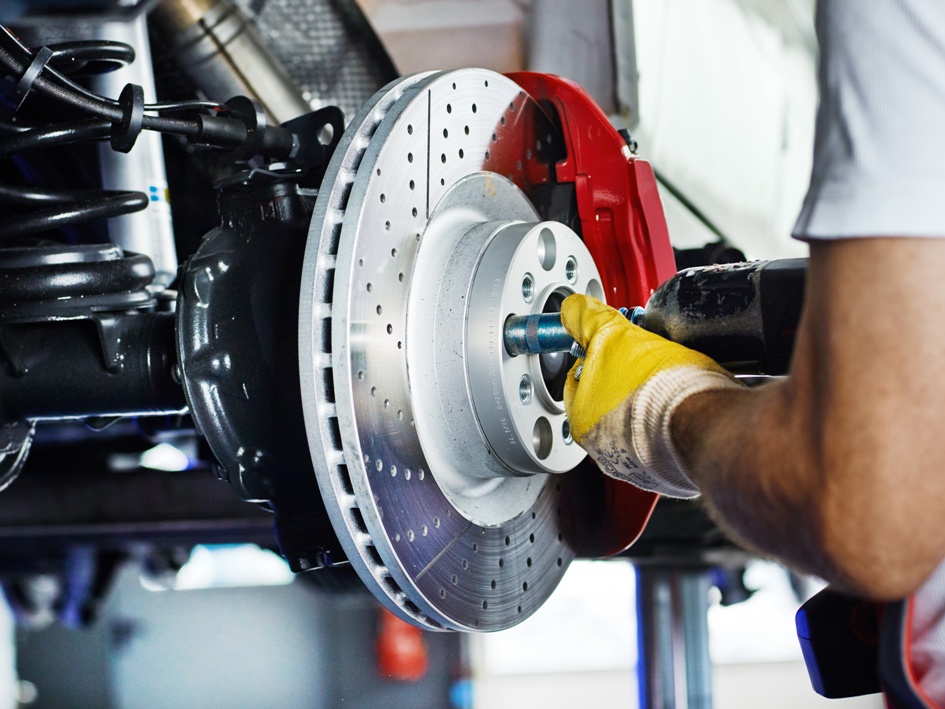Well maintained brakes are vital for driving safely. The caliper, pads, and rotors are the primary components of a braking system and are subject to a lot of wear and tear during the normal course of driving. How fast these components wear actually depends on several factors, such as:
- Driving habits: How hard a driver steps on the brake affects how long brake pads last. Some drivers ride the brakes and stop hard abruptly, while others gently coast to a stop. Smooth, gradual braking increases pad lifespan. Of course, it's important to brake abruptly when safety calls for it.
- Environment: Driving in the city is harder on brakes due to stop-and-go traffic than driving out in the country or on long straight roads. Driving in mountainous areas with steep elevation changes can wear brakes out quickly as well because it's often necessary to ride the brakes to control downhill speed.
- Weight of your vehicle: Don’t overload your vehicle more than determined by the manufacturer for optimum stopping power, calculated on the weight of the vehicle plus passenger and cargo limits. Towing heavy loads, such as trailers or boats is also a contributing factor in wearing out brakes.
- Brake pad hardness: Brake pads are available in different compounds to suit different driving needs. Hard compound brake pads, more common on performance cars, last longer, but usually need to be warm before they perform well. Soft compound brake pads perform better at low speeds, like in urban areas.
- Materials: The materials that make up the brake rotor and brake pad also factor into the brakes’ durability. Carbon-ceramic brakes last longer than standard metal braces. However, carbon-ceramic brakes are extremely expensive and found almost exclusively on high-performance sports cars. Steel or other metal brakes are much more common and still more than adequate to suit a variety of driving conditions.
So how many miles can you go before replacing brakes? Generally, brake pads need to be replaced after about 50,000 miles. Some need to be replaced after 25,000, while others can last for 70,000 miles – it all depends on the factors listed above. To get a more accurate number for your car’s specific needs, consult your owner's manual. There are a few warning signs indicating that the brake pads are wearing out, including:
- Visual Inspection. Have your mechanic inspect the thickness of your brake pads regularly, such as when your tires are rotated or the oil changed.
- Squealing or scraping noise. The wear indicators on brakes pads will start to squeal when the pads are getting too thin.
- Jittery braking. If your brakes vibrate or feel “jittery” when braking, the rotors may be warped. Your brake repair technician can clean or grind down the surface of the rotor to make it smooth and flat again. However, it may be easier, less expensive, and safer to replace the brake rotor.
If your brakes look worn out or are starting to lose their stopping performance, they should be replaced. Properly functioning brakes are key to predictable braking and safe driving!
Wondering how many miles can you go before replacing brakes? Contact our ASE Certified Technicians at Clausen Automotive, The Hybrid Shop, for more information about brake repair and to schedule an appointment. Since 1975, our family-owned auto shop has proudly served vehicle owners in Madison, WI, and the surrounding communities.

Well maintained brakes are vital for driving safely. The caliper, pads, and rotors are the primary components of a braking system and are subject to a lot of wear and tear during the normal course of driving. How fast these components wear actually depends on several factors, such as:
- Driving habits: How hard a driver steps on the brake affects how long brake pads last. Some drivers ride the brakes and stop hard abruptly, while others gently coast to a stop. Smooth, gradual braking increases pad lifespan. Of course, it's important to brake abruptly when safety calls for it.
- Environment: Driving in the city is harder on brakes due to stop-and-go traffic than driving out in the country or on long straight roads. Driving in mountainous areas with steep elevation changes can wear brakes out quickly as well because it's often necessary to ride the brakes to control downhill speed.
- Weight of your vehicle: Don’t overload your vehicle more than determined by the manufacturer for optimum stopping power, calculated on the weight of the vehicle plus passenger and cargo limits. Towing heavy loads, such as trailers or boats is also a contributing factor in wearing out brakes.
- Brake pad hardness: Brake pads are available in different compounds to suit different driving needs. Hard compound brake pads, more common on performance cars, last longer, but usually need to be warm before they perform well. Soft compound brake pads perform better at low speeds, like in urban areas.
- Materials: The materials that make up the brake rotor and brake pad also factor into the brakes’ durability. Carbon-ceramic brakes last longer than standard metal braces. However, carbon-ceramic brakes are extremely expensive and found almost exclusively on high-performance sports cars. Steel or other metal brakes are much more common and still more than adequate to suit a variety of driving conditions.
So how many miles can you go before replacing brakes? Generally, brake pads need to be replaced after about 50,000 miles. Some need to be replaced after 25,000, while others can last for 70,000 miles – it all depends on the factors listed above. To get a more accurate number for your car’s specific needs, consult your owner's manual. There are a few warning signs indicating that the brake pads are wearing out, including:
- Visual Inspection. Have your mechanic inspect the thickness of your brake pads regularly, such as when your tires are rotated or the oil changed.
- Squealing or scraping noise. The wear indicators on brakes pads will start to squeal when the pads are getting too thin.
- Jittery braking. If your brakes vibrate or feel “jittery” when braking, the rotors may be warped. Your brake repair technician can clean or grind down the surface of the rotor to make it smooth and flat again. However, it may be easier, less expensive, and safer to replace the brake rotor.
If your brakes look worn out or are starting to lose their stopping performance, they should be replaced. Properly functioning brakes are key to predictable braking and safe driving!
Wondering how many miles can you go before replacing brakes? Contact our ASE Certified Technicians at Clausen Automotive, The Hybrid Shop, for more information about brake repair and to schedule an appointment. Since 1975, our family-owned auto shop has proudly served vehicle owners in Madison, WI, and the surrounding communities.


